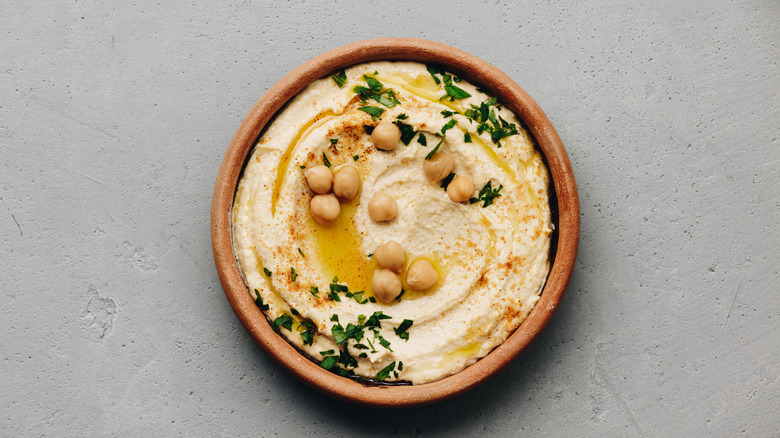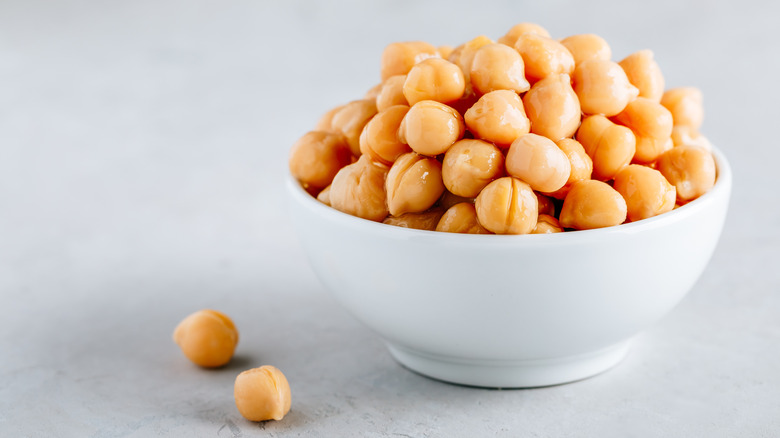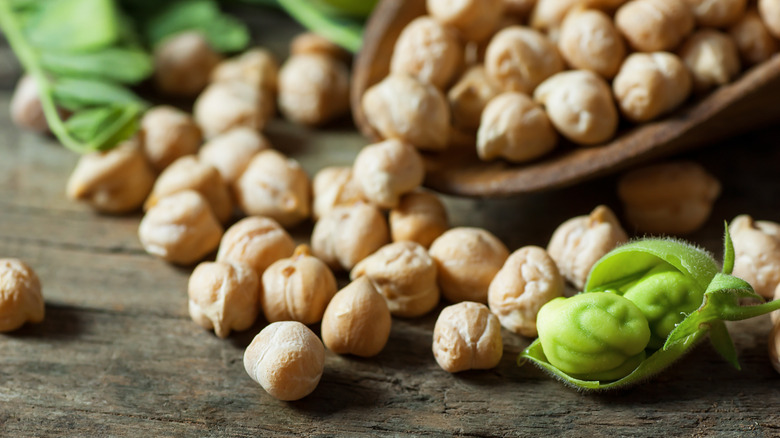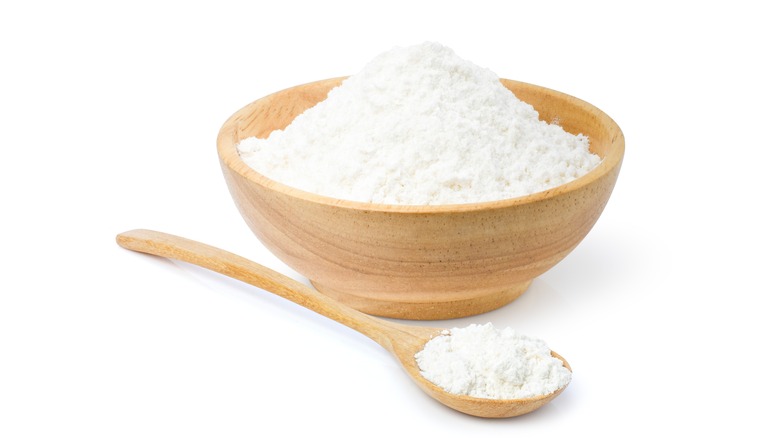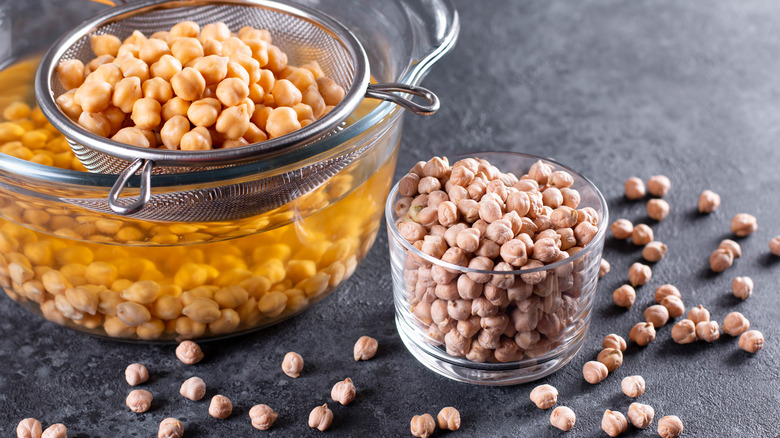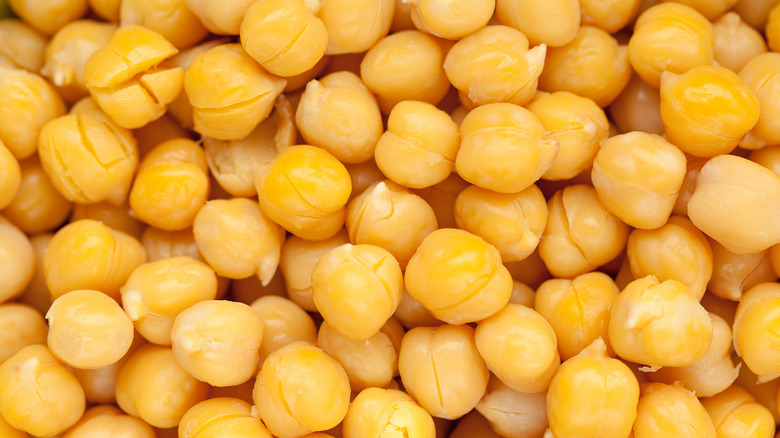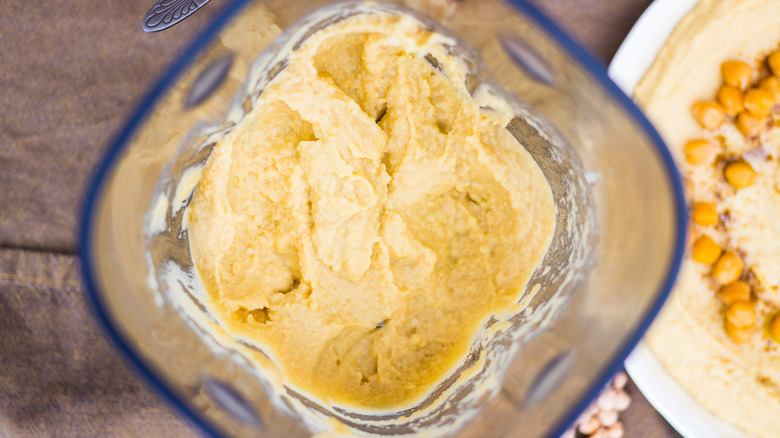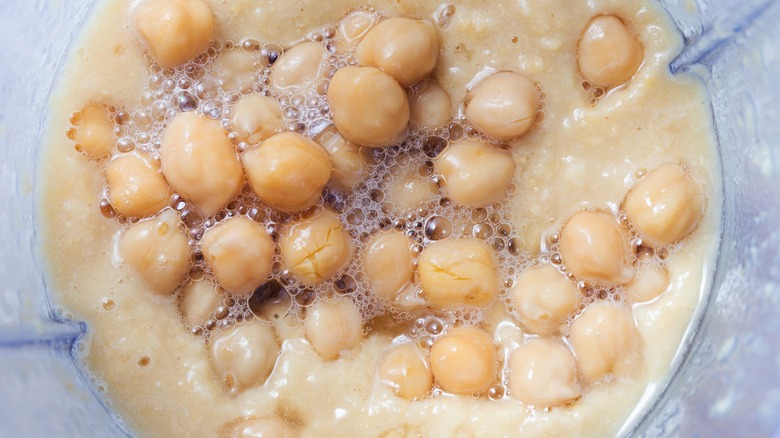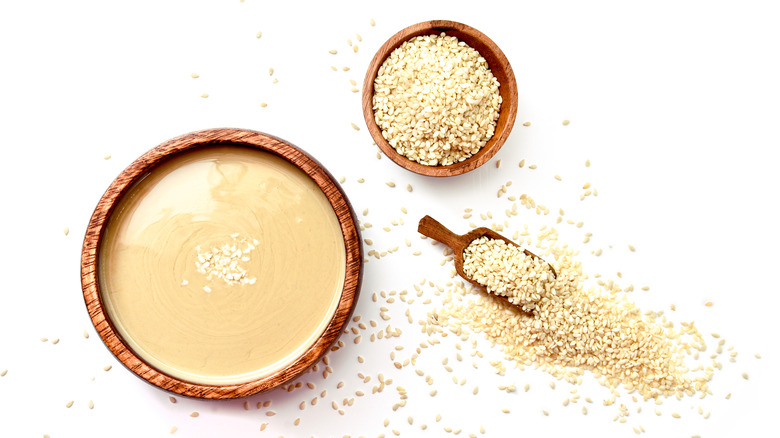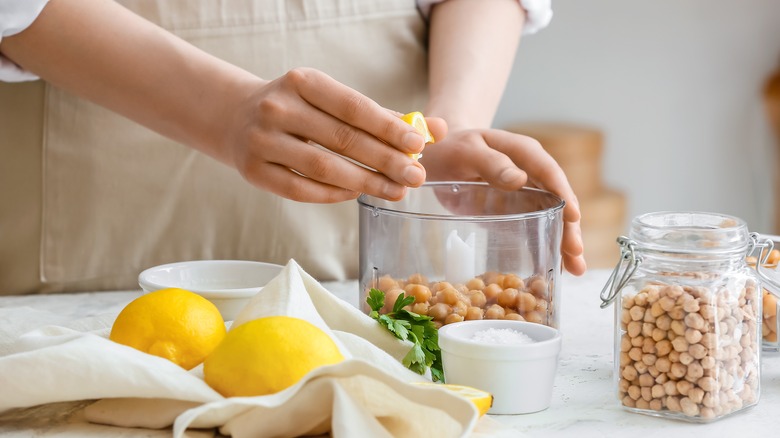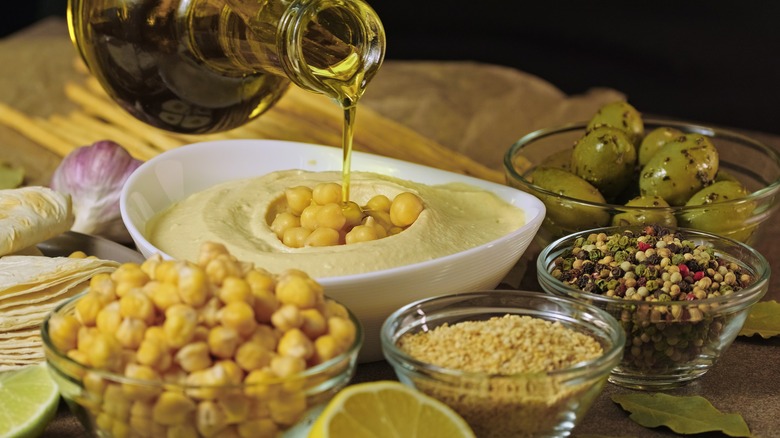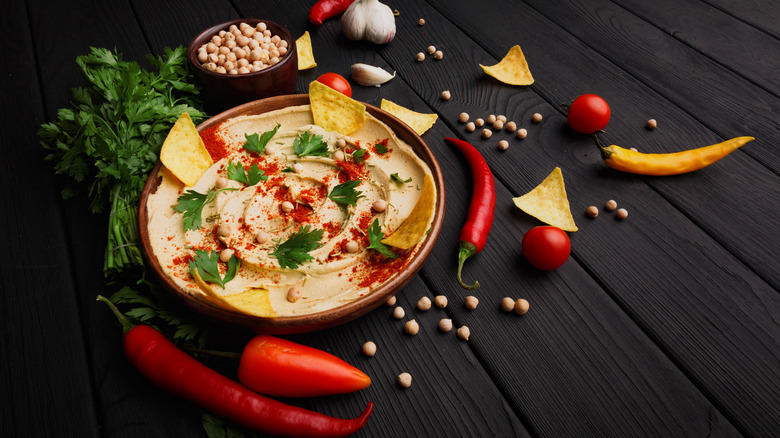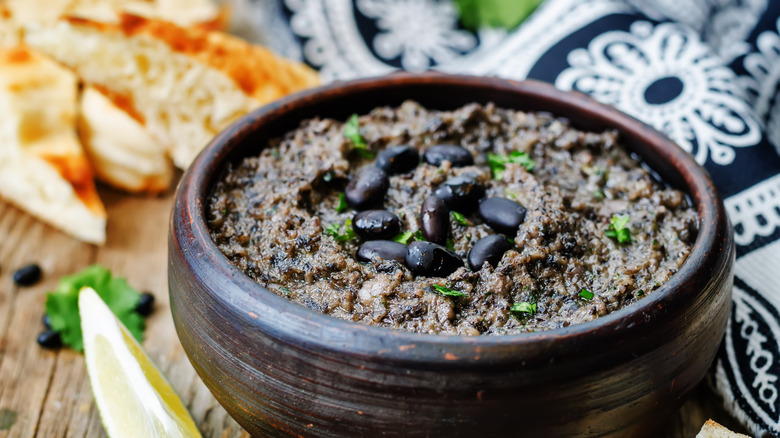Mistakes Everyone Makes With Homemade Hummus
Hummus has become a popular grocery store offering with a whole host of brands offering all manner of hummus in a wide range of flavors from lemon to chili to green curry. And while there's nothing wrong with most of these store-bought brands, homemade hummus just hits different; creamier and richer with a brighter flavor, it's definitely worth attempting at home.
That said, while the ingredients list for homemade hummus seems relatively short and sweet, it's surprisingly easy to get things wrong. Missteps could mean that all of your hard work results in a metallic-tasting hummus with a texture ranging from mealy to grainy to lumpy — far from the creaminess that an excellent homemade hummus should boast.
Luckily, expert chefs have offered some of their top tips for ensuring you reach hummus mastery at home, ranging from the ingredients to techniques to tips for serving. Here are all the mistakes they say will keep you from hummus perfection.
Using canned chickpeas
Canned chickpeas are a pantry staple perfect for pulling together a quick chickpea salad, but don't rely on this shortcut when it comes to hummus.
"When cooked from scratch, dried chickpeas become incredibly tender, resulting in a smooth and creamy hummus that melts in your mouth," explained Chef Owner Philippe Massoud of ilili restaurants. "Ultimately, using dried chickpeas in hummus allows me to create a homemade dip that is truly exceptional."
And texture isn't the only reason you should opt for dried. According to Massoud, canned chickpeas can often have a metallic flavor due to the preservation process, an assertion with which Tom Aviv, "MasterChef Israel" winner and chef of Branja in Miami, agrees.
"Technically, the main reason for using dried chickpeas over canned is because canned anything usually has a distinct 'canned' taste/smell to it, which can impact the flavor of the hummus," he said. "An added benefit of using dried is that you are in control over how long you want to cook your chickpeas, and how smooth you want the hummus to be."
If, however, you do decide to take this shortcut, Massoud has some advice. He said, "If you use canned chickpeas, rinse them thoroughly and cook them for at least 45 min and then drain them like you would dry ones."
You'll lose some of that canned flavor and obtain a much creamier texture.
Using the wrong variety of chickpeas
Chickpeas come in all shapes and sizes, and not all are equally suited to making hummus. Most chickpeas fall into one of two categories — desi and kabuli. Desi chickpeas tend to be smaller and darker, while kabuli are typically lighter and larger, not to mention far more commonly found in the U.S. But within these larger categories, you'll find loads of different varieties, including Mexican, Israeli, and Bulgarian chickpeas, as well as chickpeas that have been treated or preserved in different ways such as Bengal gram or black chickpeas, and chana dal or split chickpeas.
When making hummus, your best bet is to seek out one of the Middle Eastern varieties, which will be smaller than many others and will thus cook through faster. While Aviv notes that different varieties of chickpeas are preferred in different regions, at Branja, the team likes small Moroccan chickpeas despite the fact that they're far from the most commonly used option.
"They pack a little bit of extra starch that makes the final product super creamy," he said. "As an added bonus, they cook a lot faster than the large ones."
Not using baking soda
Once you've picked your chickpeas, it's time to get cooking. And our experts agree: You don't want to cook the chickpeas all on their own. A touch of baking soda raises the pH of the water to help the chickpeas break down, rendering the purée extra smooth. Plus, according to Aviv, baking soda helps the chickpeas cook even faster, shaving the cooking time by half. He recommended seasoning the chickpea water with baking soda as you would pasta water with salt — a teaspoonful is more than enough for a pot.
"Most of the baking soda gets drained off with the water when you drain the chickpeas," he said. "So it has no effect on the taste."
Other experts use baking soda twice: Once when soaking the chickpeas, and then again while cooking. Either way, don't forget this easy step if you want your finished hummus to have the perfect texture.
Undercooking the chickpeas
According to Aviv, the most common mistake people make when making hummus at home is not cooking their chickpeas for long enough, which is understandable considering how long it actually takes to cook dried chickpeas through. You're looking at about 90 minutes to two hours on the stovetop after an overnight soak, or 50 minutes plus a 10-minute natural release if you're using a pressure cooker. It's a time investment, for sure, but Aviv said rushing this process "results in a grainy texture" in your finished hummus. "And once you start blending, there's no going back."
If you're not sure if your chickpeas are cooked through enough, he recommended erring on the side of caution and continuing to cook them for a few extra minutes until they're truly soft enough to purée.
"Don't be afraid to even 'overcook' them, because it will be blended anyway," he said.
Not peeling your chickpeas
Peeling chickpeas may sound super fastidious, but it really is necessary if you want a super smooth final result. Luckily, that aforementioned baking soda trick doesn't just make chickpeas cook up softer; it also usually makes it way easier to peel the chickpeas once they're cooked. When you add baking soda to the water, most of the skins should slip off during the cooking process and rise to the surface, meaning all you need to do is skim them off with a slotted spoon before draining the chickpeas and giving them a once-over to remove any straggling skins.
If going over the chickpeas one-by-one seems like a bit too much work, there's one more trick you can use: A doubled-over kitchen towel will make it far easier to handle the chickpeas. Just scatter them in an even layer over the towel and rub them for a few seconds. The skins should slip right off.
Blending the chickpeas at the wrong temperature
Most experts say that cooked chickpeas should be blended hot for the creamiest hummus, an assertion Aviv has backed 100%.
"This will ensure you get the best texture," he said. "However, depending on the equipment you're using, you might need to let it cool off just a bit so the hot chickpeas don't damage or ruin your machine."
That said, other experts recommend cooling the chickpeas down entirely before blending — and not just to keep your equipment in tip-top shape, but for a wholly different reason.
"To avoid having a watery hummus it is recommended to strain them for a couple of hours," said Massoud. "It's a small but significant step that contributes to achieving the perfect texture and flavor balance in your homemade hummus creation."
He added that if hummus warms up too much while blending, it could begin to ferment and lose some of its freshness. The executive chef of Spain Wine Bar, chef Oscar Benitez, also finds that "it is better to blend them after they get cold, so I usually will blend the next day."
Underblending
Properly prepared hummus should be creamy and smooth, which is why you may need to blend your hummus for longer than you'd assume.
"It's key to remember that viscosity and texture are very important," said Benitez. "Even if you use the correct ingredients, you want to make sure you don't over or under blend. That will ruin the experience."
This is particularly true if you're not using professional-grade equipment, which can take the long blending time hummus requires without the motor of the machine heating up too much. To avoid damaging your home equipment, consider blending your hummus in batches and giving your blender or food processor a break if it begins to heat up. Depending on the machine you use, this could take anywhere from a minute to five minutes of blending. It almost goes without saying that any electric machine will definitely be quicker than the more traditional mortar and pestle method.
Using low-quality tahini
Tahini is one of the main flavoring agents for hummus, so it's important to invest in a top-quality one.
"Tahini is one of those make it or break it type ingredients in hummus," said Aviv. "While it's used in small quantities, it is an intense and flavorful ingredient, and you cannot ignore its presence."
For him, the quality of the tahini you use is just as important as that of the chickpeas, and Massoud agrees.
"As a hummus aficionado, who has experimented with various tahini brands and types, I assure you that using high-quality tahini has made a noticeable difference in the overall taste profile of hummus," he said. "The subtle nuances and aromatic notes of a good-quality tahini can truly elevate the taste of the entire dish."
He usually turns to Lebanese tahini, which, he said, "Seems to have the superior taste that we look for." He continued, "The sesame [seeds] are not over roasted, and therefore the tahini is almost sweet."
Underseasoning hummus
Hummus can take a lot of seasoning, so don't be shy. "Similar to potatoes, it requires a lot of salt to make chickpeas taste properly seasoned," said Aviv.
That said, you don't want to season too heavily either, lest all that hard work and waiting be damaged by too heavy a hand with salt. Luckily, Aviv has some advice to ensure you never ruin a batch with overzealous seasoning. "A little trick we do at Branja if we're unsure whether it needs more seasoning, instead of risking the whole mass, just take out a spoonful, season only that and taste," he said. "If it tastes better, then go ahead and season the rest of the mass."
And salt's not the only seasoning you can be generous with. Benitez said you're shooting for the ideal balance among the other seasonings too. "I love tahini, garlic and lemon juice," he said, "so those elements are the key ingredients in my hummus."
Massoud, meanwhile, eschews both garlic and cumin in his hummus, which stays true to Lebanese tradition.
"A lot of people in the Middle East will add cumin and or garlic, however that is not how it is made in Lebanon," he said. "Hummus in Lebanon does not have any additional flavors, it's the perfect balance of the chickpeas, lemon, tahini, and salt for seasoning."
Not using enough olive oil
Much like salt, according to Aviv, olive oil is an essential seasoning for hummus. While it's more likely you'll under- than over-season, at least at first, there's a bit of a "to each his own" mentality here. "There needs to be a base amount added in order for the hummus to be well made, but any more oil is totally a personal taste," he said.
Massoud agrees. "The amount of olive oil added to hummus can depend on personal taste, dietary considerations, and desired texture," he said. "Some people may indeed add a sufficient amount of olive oil to their hummus, considering it an integral component for achieving a rich and smooth texture, as well as enhancing the overall flavor profile."
And unsurprisingly, the quality of the oil is just as important as the quantity. "Having a good quality olive oil on hand will always elevate the flavors of any dish — especially hummus," said Benitez.
And it should go without saying that cutting corners by using cheaper oils negates the spirit of the dish.
"There are also individuals who opt for a drier and firmer consistency or prefer to highlight other flavors without the prominence of olive oil," said Massoud. "The problem is that nowadays people are adding too much oil to the hummus and most of the time it is not olive oil but rather canola and or soy oil, that defeats the purpose of the healthy classification of the dish."
Not plating beautifully or creatively
If you're going to put all of the effort into making a delicious homemade hummus, you owe it to yourself and your guests to serve it beautifully. However, as for what exactly that means, you can let your imagination be your guide.
"At Spain Wine Bar we use a traditional Spanish-style plate that is called a cazuela, or a shallow cooking pot," said Benitez. "We serve roasted red pepper hummus with some fried chickpeas on top, and pimentón, salt and olive oil to finish."
Aviv prefers his hummus "kharif ve lemon," which means "spicy and lemon" in Hebrew. He's also partial to, in his words, "Loads of olive oil, cumin, [and] some whole chickpeas on top."
Massoud, meanwhile, uses hummus as a base for all sorts of interesting toppings, which can add texture and color to the finished dish.
"Topping the hummus is where the fun can happen, whether it's simple pine nuts, sautéed jalapeños and/or serrano, or any protein you fancy," he said.
At ilili, he serves hummus with anything from brown butter-toasted pine nuts, mushrooms, or confit lamb. But his favorite is perhaps the simplest, featuring a "generous drizzle of Lebanese olive oil in the center and pinch of Aleppo pepper."
Not using chickpeas
You've likely stumbled upon references to anything from split pea hummus to cannellini bean hummus, but for our experts, these dishes veer way off course, and not simply because the word hummus is Arabic for "chickpea," although that's definitely part of it.
"Is a chicken sandwich still a chicken sandwich if we use tofu instead of chicken?" asked Aviv. "Surprise answer: of course not. Call it lentil spread, or whatever you want, but it's not technically hummus without chickpeas."
Massoud agreed. "Hummus should always be made with chickpeas, otherwise it should be called dip xyz and not hummus," he said.
But Aviv clarified, "We're not the technical police of food names," and if you're feeling in a creative mood, you can easily make hummus with any pulse, from black beans to cranberry beans.
"You do what you want," says Aviv ... but given the strong feelings of these experts, we'd recommend calling any hummus not featuring chickpeas "bean dip."
